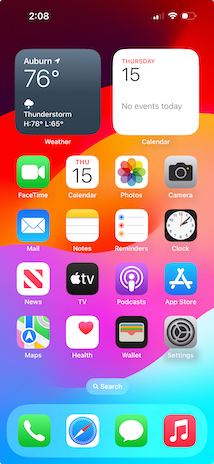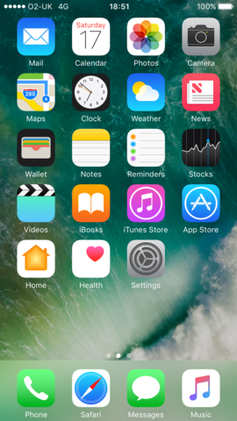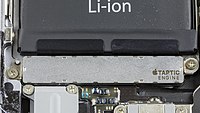Haptic technology is technology that can create an experience of touch by applying forces, vibrations, or motions to the user. These technologies can be used to create virtual objects in a computer simulation, to control virtual objects, and to enhance remote control of machines and devices (telerobotics). Haptic devices may incorporate tactile sensors that measure forces exerted by the user on the interface. The word haptic, from the Greek: ἁπτικός (haptikos), means "tactile, pertaining to the sense of touch". Simple haptic devices are common in the form of game controllers, joysticks, and steering wheels.

Immersion Corporation is an Aventura, Florida based developer and licensor of touch feedback technology, also known as haptic technology. Immersion Corporation has been accused of being a patent troll. Founded in 1993 by Louis Rosenberg, it is currently headed by lawyer Francis Jose, who serves as both chief executive officer and general counsel.

A virtual keyboard is a software component that allows the input of characters without the need for physical keys. Interaction with a virtual keyboard happens mostly via a touchscreen interface, but can also take place in a different form when in virtual or augmented reality.

iOS is a mobile operating system developed by Apple Inc. exclusively for its smartphones. It was unveiled in January 2007 for the first-generation iPhone, launched in June 2007.

webOS, also known as LG webOS and previously known as Open webOS,HP webOS and Palm webOS, is a Linux kernel-based multitasking operating system for smart devices such as smart TVs that has also been used as a mobile operating system. Initially developed by Palm, Inc., HP made the platform open source, at which point it became Open webOS.

The Magic Trackpad is a multi-touch trackpad produced by Apple Inc. The first generation version was released on July 27, 2010, and featured a trackpad 80% larger than the built-in trackpad found on the then-current MacBook family of laptops. A redesigned second generation version, initially marketed as Magic Trackpad 2, was released on October 13, 2015.
The following outline of Apple Inc. is a topical guide to the products, history, retail stores, corporate acquisitions, and personnel under the purview of the American multinational corporation Apple Inc.

Health is a health informatics mobile app, announced by Apple Inc. on June 2, 2014, at its Worldwide Developers Conference (WWDC). The app is available on iPhone and iPod Touch devices running iOS 8 or later, and on iPads running iPadOS 17 or later. The application holds health data such as blood pressure measurement and glucose levels, but also holds physical tracking data such as step counts. It can pull data from fitness trackers, smartwatches, smart scales, and other devices.

watchOS is the operating system of the Apple Watch, developed by Apple Inc. It is based on iOS, the operating system used by the iPhone, and has many similar features. It was released on April 24, 2015, along with the Apple Watch, the only device that runs watchOS. watchOS exposes an API called WatchKit for developer use.

The iPad Air 2 is the second-generation iPad Air tablet computer designed, developed, and marketed by Apple Inc. It was announced on October 16, 2014, alongside the iPad Mini 3, both of which were released on October 22, 2014. The iPad Air 2 is thinner, lighter and faster than its predecessor, the first-generation iPad Air, and features Touch ID with the height, width and screen size the same as the iPad Air.

iOS 9 is the ninth major release of the iOS mobile operating system developed by Apple Inc., being the successor to iOS 8. It was announced at the company's Worldwide Developers Conference on June 8, 2015, and was released on September 16, 2015. It was succeeded by iOS 10 on September 13, 2016.

The iPhone 6s and iPhone 6s Plus are smartphones that were designed, developed, and marketed by Apple Inc. They are the ninth generation of the iPhone. They were announced on September 9, 2015, at the Bill Graham Civic Auditorium in San Francisco by Apple CEO Tim Cook, with pre-orders beginning September 12 and official release on September 25, 2015. They were succeeded by the iPhone 7 and iPhone 7 Plus on September 7, 2016 and were discontinued with the announcement of the iPhone XS, iPhone XS Max, and iPhone XR on September 12, 2018.

The iPad Mini 4 is the fourth-generation iPad Mini tablet computer designed, developed and marketed by Apple Inc. It was announced along with the iPad Pro on September 9, 2015, and released the same day. The iPad Mini 4, which replaced the iPad Mini 3, was discontinued on March 18, 2019, when it was replaced by the fifth-generation iPad Mini. It features most of the hardware similar to the iPad Air 2 including its laminated display and design.

iOS 10 is the tenth major release of the iOS mobile operating system developed by Apple Inc., being the successor to iOS 9. It was announced at the company's Worldwide Developers Conference on June 13, 2016, and was released on September 13, that year. It was succeeded by iOS 11 on September 19, 2017.

iOS 11 is the eleventh major release of the iOS mobile operating system developed by Apple Inc., being the successor to iOS 10. It was announced at the company's Worldwide Developers Conference on June 5, 2017, and was released on September 19, 2017. It was succeeded by iOS 12 on September 17, 2018.

iOS 12 is the twelfth major release of the iOS mobile operating system developed by Apple Inc. Aesthetically similar to its predecessor, iOS 11, it focuses more on performance than on new features, quality improvements and security updates. Announced at the company's Worldwide Developers Conference on June 4, 2018, iOS 12 was released to the public on September 17, 2018. It was succeeded for the iPhone and iPod Touch by iOS 13 on September 19, 2019, and for the iPad by iPadOS 13 on September 24, 2019. Security updates for iOS 12 continued for four years after the releases of iOS 13 and iPadOS 13 for devices unable to run the newer versions. The last update, 12.5.7, was released on January 23, 2023.

iOS 13 is the thirteenth major release of the iOS mobile operating system developed by Apple Inc. for the iPhone, iPod Touch and HomePod. The successor to iOS 12, it was announced at the company's Worldwide Developers Conference (WWDC) on June 3, 2019, and released on September 19, 2019. It was succeeded by iOS 14, released on September 16, 2020.

iPadOS 13 is the first major release of the iPadOS mobile operating system developed by Apple Inc. for their iPad line of tablet computers. The successor to iOS 12 on those devices, it was announced at the company's 2019 Worldwide Developers Conference (WWDC) on June 3, 2019, as a derivation from iOS, with a greater emphasis on multitasking and tablet-centric features. It was released on September 24, 2019. It was succeeded by iPadOS 14, released on September 16, 2020.

iOS 15 is the fifteenth major release of the iOS mobile operating system developed by Apple for its iPhone and iPod Touch lines of products. It was announced at the company's Worldwide Developers Conference on June 7, 2021, as the successor to iOS 14 and released to the public on September 20, 2021.
The iPhone's hardware is designed by Apple Inc. Apple directly sub-contracts hardware production to external OEM companies, maintaining a high degree of control over the end product.





















